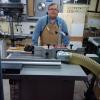I was cutting some bridle joints on the table saw the other day, cutting the slots on the end of the board ( 2 1/2in), taking about 1/8 off with each pass when my biggest nightmare came true, kick-back right in the face. Needless to say it knocked me out and I ended up with a hair line fracture of the left checkbone, just missing my left eye. My neighbor was there and he said it happened so fast he couldn't believe his eyes. I was standing there one second and the next thing I know he was sitting me up against the wall. I don't know what I did wrong, I was using a jig that had more than ample rear and side support, using my Frued box cutter blades alligned for 1/4in width, and like I said cutting about 1/8in with each pass, PLUS I was standing to the left of the board I was cutting, I thought and still do believe I was doing everything correct and safe. Would using a decent coping sled be a better and safer option? I have big enough slot cutters to use. I've always taken extra care when standing boards up to cut. After this incident, I don't have the cajones to finish the door. Thanks in advance for any advise or thoughts. Could there have been a chance I hit a void in the wood? I was cutting red oak.




 Reply With Quote
Reply With Quote



